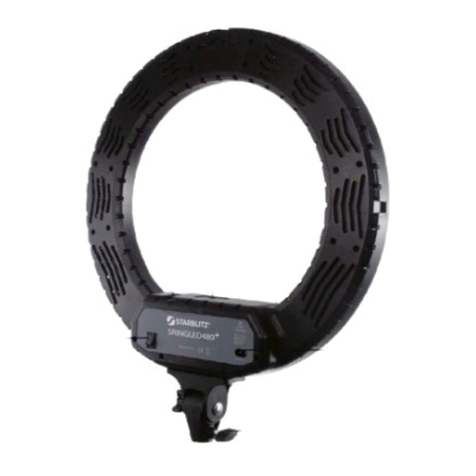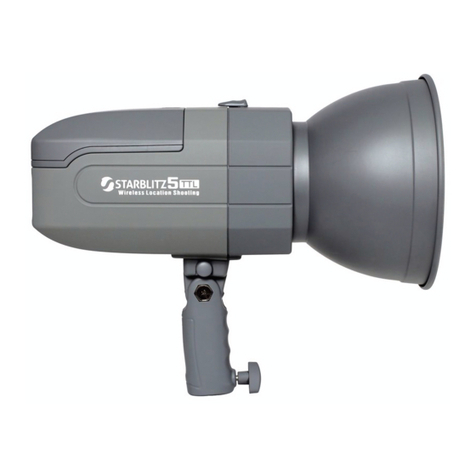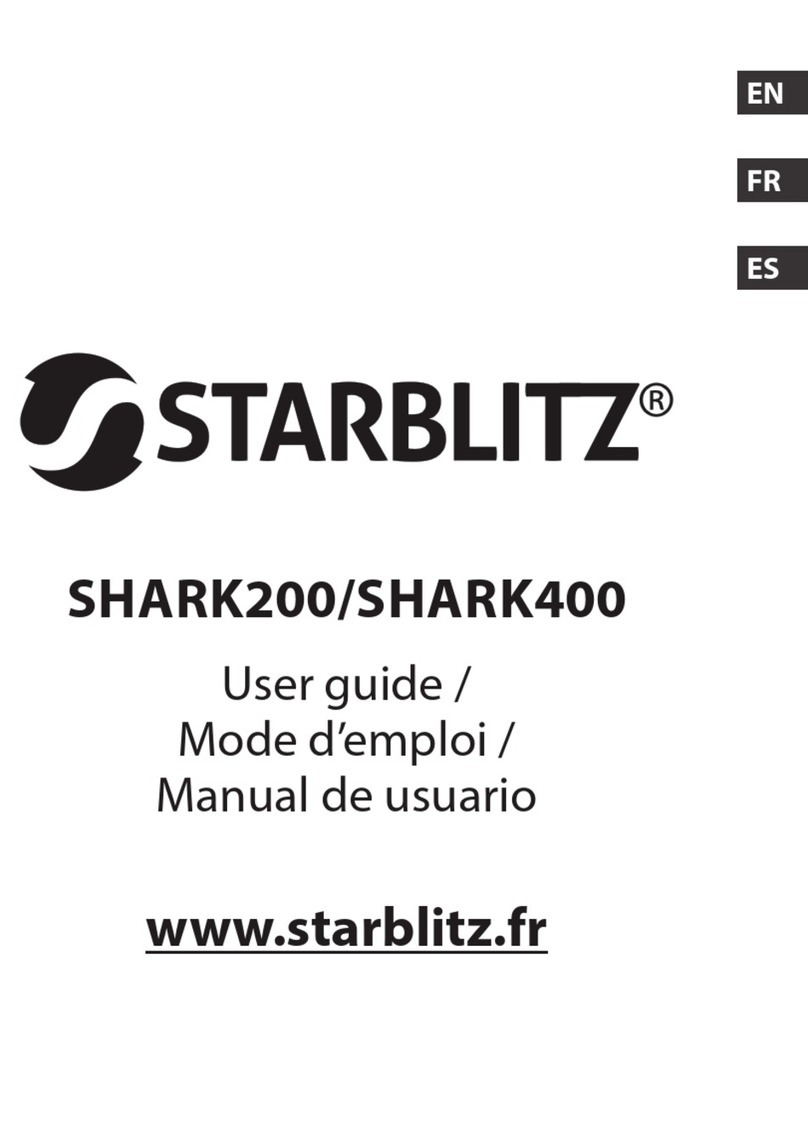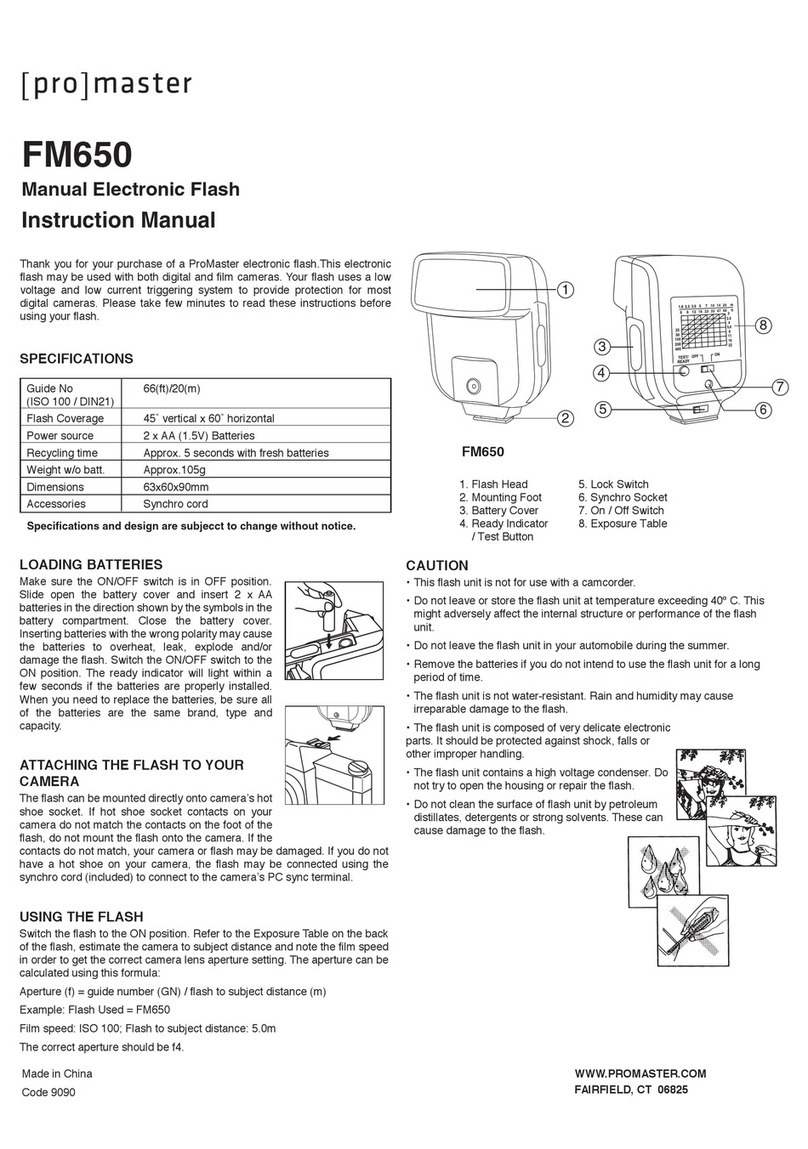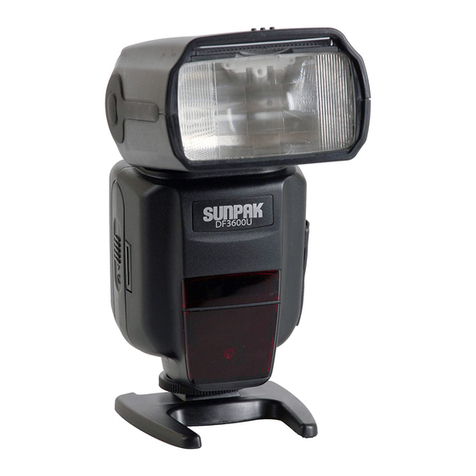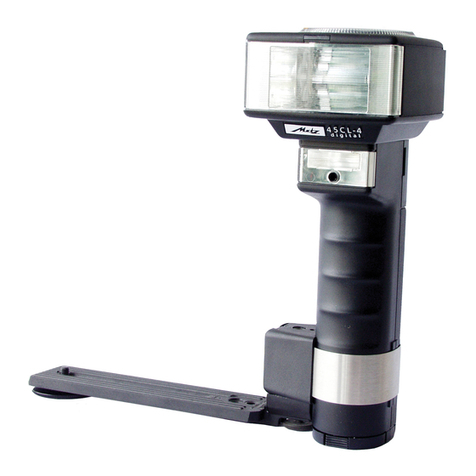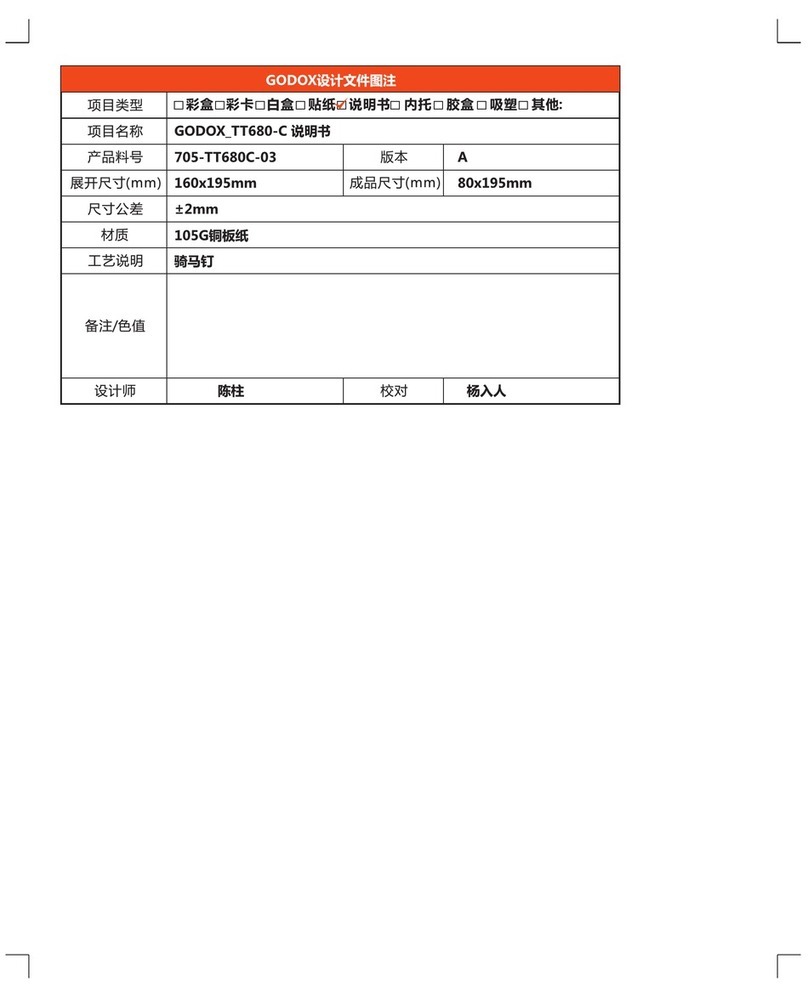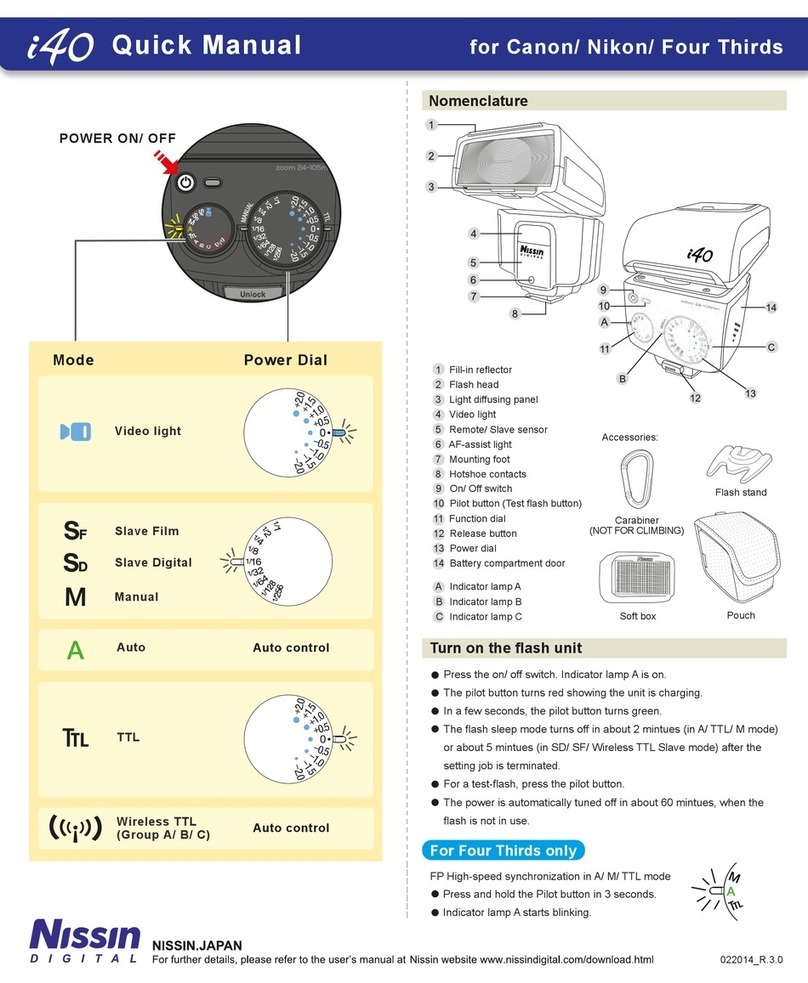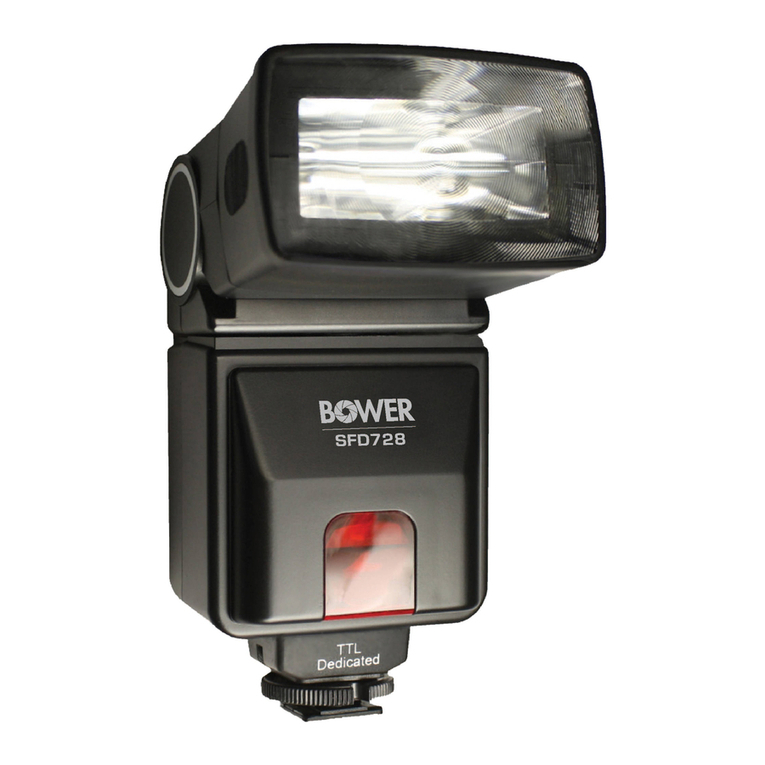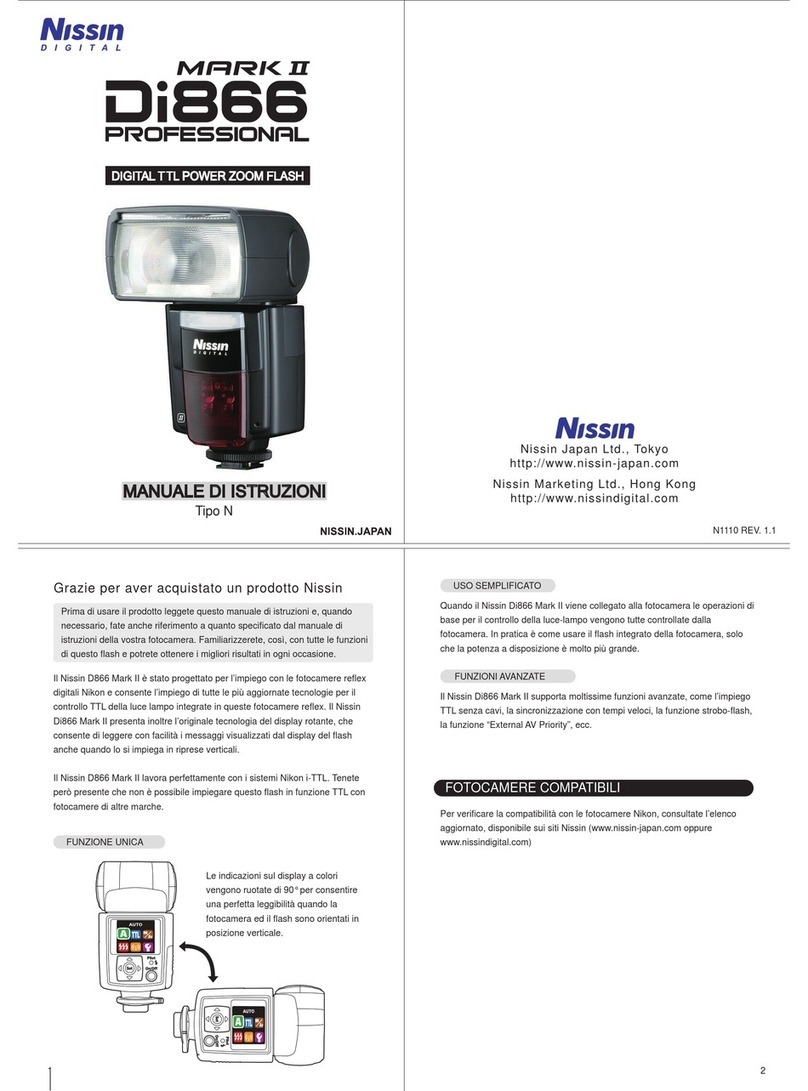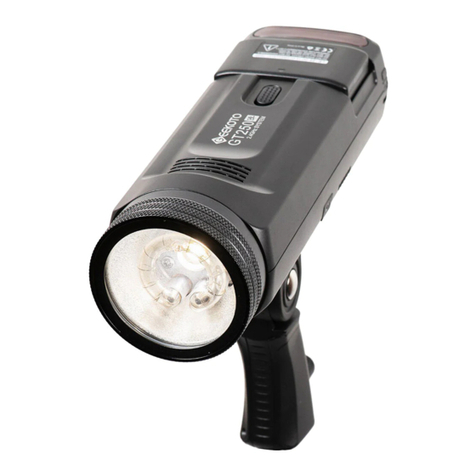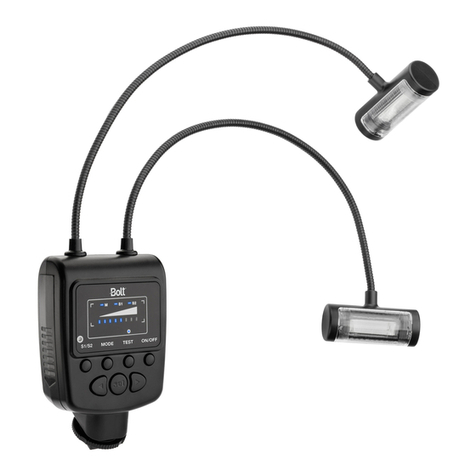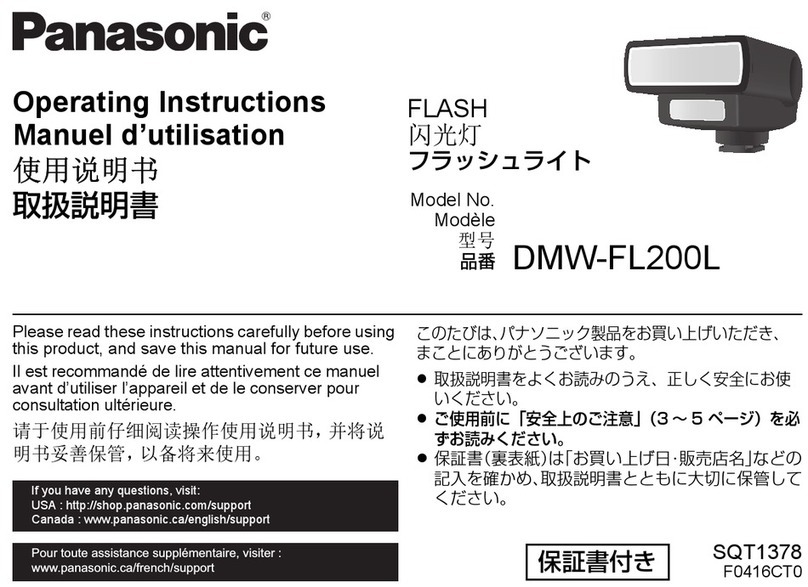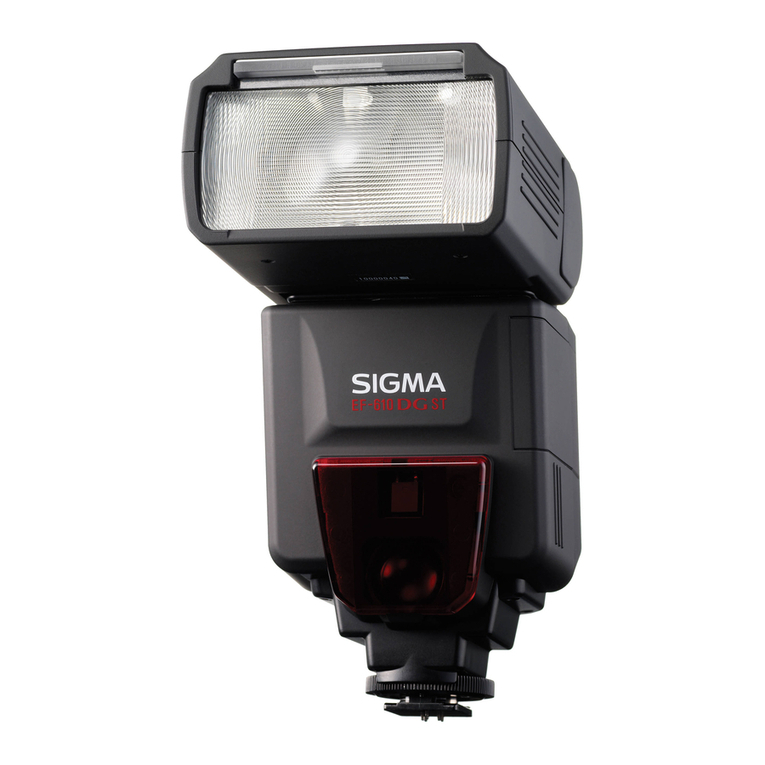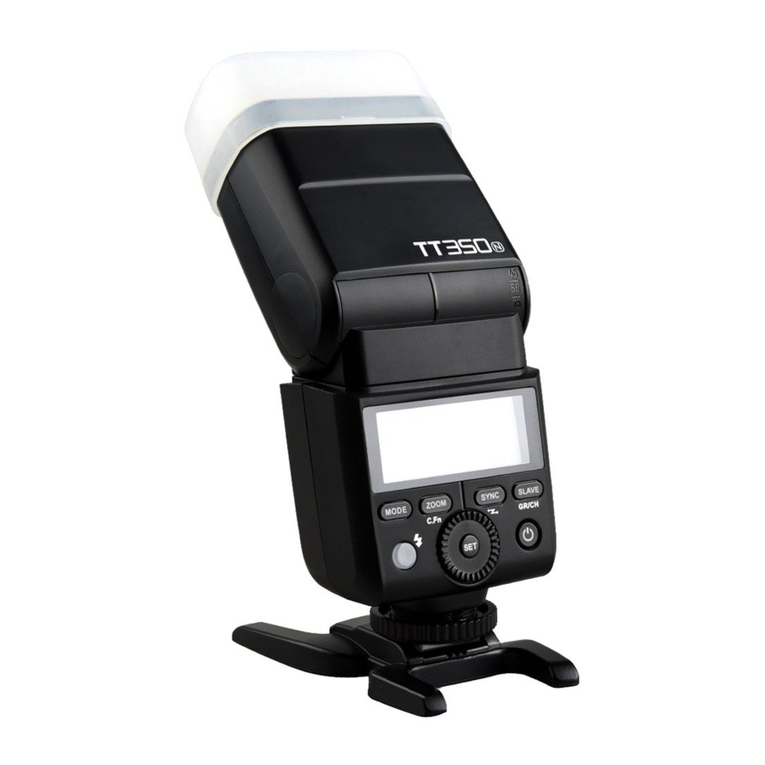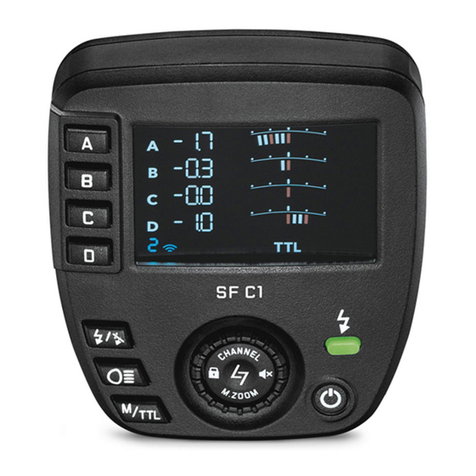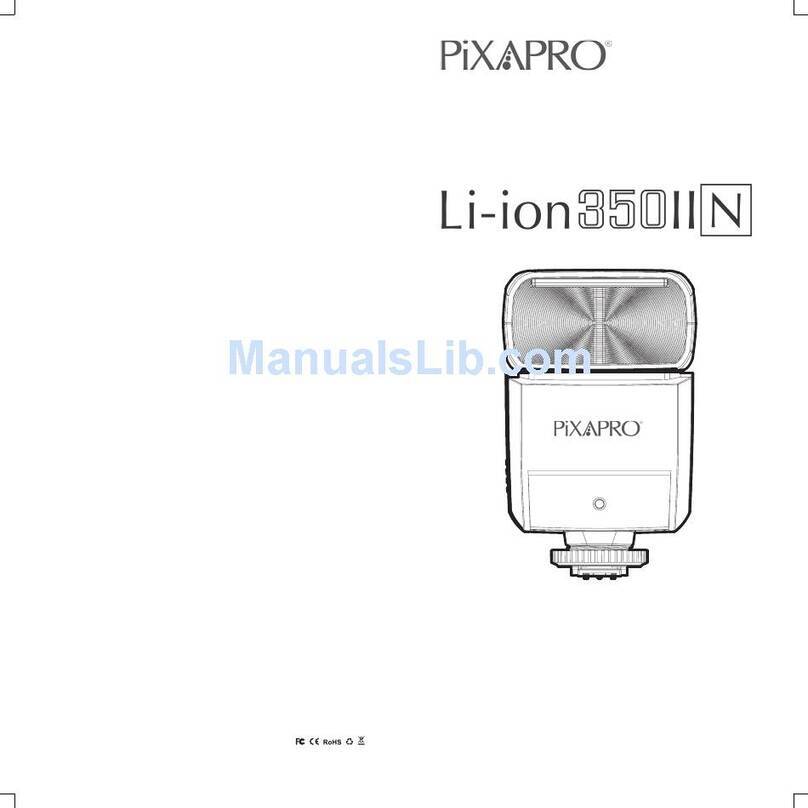Starblitz SWAN27C User manual

1
SWAN27C/SWAN27N
User guide / Mode d’emploi / Manual de instrucciones
www.starblitz.fr
EN
FR
ES


1
EN
FR
ES
Contents
Caution ...................................................................... 2
Components ............................................................. 5
Installing the batteries ........................................... 6
Recycling Time and Flash Count ........................... 6
Manual Exposure ..................................................... 7
Attach the Speedlite ............................................... 7
Switching Flash Coverage ...................................... 8
Bounce Flash Shooting ........................................... 9
Eective usage of Speedlite ............................... 10
Troubleshooting Guide ....................................... 12
Flash Shooting Range Guidelines ...................... 13
Specications ........................................................ 13
Flash camera
STARBLITZ®
SWAN27C/SWAN27N
User guide

2
EN
FR
ES
Caution
If corrosive liquids seep from the batteries and
get in your eyes,immediately wash your eyes with
running water and consult with a doctor.Your eyes
could be seriously damaged if they are not treated
quickly.
If corrosive liquids seep from the batteries and
come in contact with your skin or clothes, wash
immediately with running water.Prolonged contact
could injure your skin.
Never attempt to disassemble or repair the ash
by yourself,as this could result in you receiving an
elctric shock and could also cause the ash to mal-
function; such malfunction could lead to personal
injury.
If the ash is dropped and damaged,do not touch
any exposed interior metal parts. Such parts,espe-
cially the speedlight’s capacitor and associated
parts,could be in a high-charge state and if touched
could cause an electric shock. Disconnect the power
or remove the batteries and be sure that you do not
touch any of the product’s electrical components.
If you detect heat,smoke or notice a burning
smell,immediately stop operation and remove the
batteries to prevent the ash from catching on re
or melting. Allow the ash to cool down so that you
can safely touch it and remove the batteries.
The ash should never be submerged in liquid
or exposed to rain,saltwater or moisture unless it is
properly protected from the liquids and moisture.
Underwater use requires a certied underwater
housing.If water or moisture gets inside the ash,
this could cause the ash to catch on re or cause an
electric shock. In such instances you should imme-
diately remove the batteries from the ash.
Note: electronic devices that are penetrated by water
or moisture are often not economically repairable.
Do not use the ash in the presence of ammable
or explosive gas.If the ash is operated in areas
where there is a ammable gas,including propane,
gasoline and dust, it could cause an explosion or re.

3
EN
FR
ES
Do not re the ash directly at the driver of a mo-
ving car.
Do not re the ash directly into the eyes of
someone that is at close range, as it could damage
their eyes’retinas. Never re the ash closer than 1
meter from infants.
Do not re the ash while the ash is touching a
person or object.Such use can result in the person
being burned, and/or their clothes igniting from the
heat of the ash’s ring.
Keep small accessories out of the reach of child-
ren to avoid the possibility of the accessory being
swallowed. If an accessory is accidentally swallowed,
immediately consult with a doctor.
Use only the batteries specied in this instruction
manual.Batteries other than those specied could
leak corrosive liquids, explode or catch on re or
otherwise not perform satisfactorily.
Do not mix battery types,brands or old and
new batteries,as the batteries could leak corrosive
liquids, explode or catch on re. When using more
than one battery in a product, always use identical
batteries that were purchased at the same time.
Non-rechargeable batteries such as manganese,
alkaline-manganese and lithium batteries should
never be charged in a battery charger because they
could leak corrosive liquids, explode or catch on re.
When using standard size (AA,AAA,C,D) or other
common rechargeable batteries such as NiCd and
Ni-MH battery types,or when recharging them,be
sure to use only the battery charger specied by the
battery maker and read the instructions thoroughly.
Do not recharge these batteries with their termi-
nals reversed in the charger or before the batteries
have cooled o suciently because they could leak
corrosive liquids, explode or catch on re. The same
cautioo applies to using the rechargeable batteries
that may be supplied by the photo product’ s ma-
nufacturer.

4
EN
FR
ES
Do not touch the ash with wet hands,as this
could cause an electric shock.
Keep the ash away from children to prevent
them from putting the falsh in or near their
mouth,or otherwise touching a dangerous part of
the product, as suchcontact could cause an electric
shock.
Do not apply strong physical shocks to the
ash,as this could cause a malfunction that could
cause the ash to explode or catch on re.
Never use active agents that contain ammable
substances such as paint thinner, benzene or paint
remover to clean the ash,and never store the ash
in locations containing chemicals such as camphor
and naphthalene,as this could damage the plastic
case, causea re or cause an electric shock.
Remove any batteries from the ash before sto-
ring the ash for a long time to prevent the ash
from catching on re or leaking corrosive liquids.
Don’t excess the allowed continuous shooting
quantity(see below table format) You should rest
the ash unit at least 10 minutes after the conti-
nuous quantity reaches the maximum.
Flash output 1/1 1/2 1/4 1/8 1/16 1/32 1/64 1/128
Flash Time 10 20 40

5
EN
FR
ES
Composants
Flash head
Batteries compartment cover
Hot shoe x nut
Locking pin
Hot shoes contacts
Bounce angle index
Indicator / Test ring
Power button
Locking button

6
EN
FR
ES
Installing the batteries
Slide the battery compartment cover and open it
as shown by the arrows.
Install two batteries.
Make sure the + and - battery contacts are correctly
oriented.
Return the cover to its original position.
Install two AA-type penlight batteries (1.5V or
lower) of any of these types.
Recycling Time
and Flash Count
Recycling Time: 0.1 - 4 sec.
Flash Count: 100 - 680 ashes
Based on new size-AA alkaline batteries testing
standards.
Be sure to use a new set of two batteries of the
same brand. When replacing the batteries, replace
both batteries at once.
Do not re more than 20 continuous ashes in
a short time.

7
EN
FR
ES
If you re more than 20 continuous ashes in a
short time, the overheating prevention function
may be activated and make the recycling time
about 8 to 20 sec. If this occurs, allow a rest time of
about 15 min. and the functioning of the ash will
then return to normal.
Using AA-size batteries other than the alkaline
type may cause improper battery contact due to the
irregular shape of the battery contacts.
Size-AA Ni-MH or lithium batteries can also be
used.
Manual Exposure
You need to set shutter speed and aperture to get
best exposure as the ash unit’s output is the same.
Attach the Speedlite
Be sure to turn o the camera and ash before ins-
talling or removing the ash.
Ready to attach the Speedlite.
Loosen the locking ring by turning it in the direction
of the arrow.

8
EN
FR
ES
Attach the Speedlite.
Mount the Speedlite into the camera’s hot shoe all
the way.
Switching Flash Coverage
Flash head (normal position):
The Guide No. is 22 (ISO 100 in meters/feet).
Flash head (pulled forward):

9
EN
FR
ES
Bounce Flash Shooting
By pointing the ash head toward a wall or ceiling,
the ash will bounce o the surface before illumi-
nating the subject. This can soften shadows behind
the subject for more natural-looking shots.
Pull the ash head forward and then tilt it upward
to determine the ash head angle.
When the resulting picture is dark, set smaller
F number (open the aperture) or increase the ISO
speed and try shooting again.
The resulting picture may also be dark if the wall or
ceiling is too far away.
The wall or ceiling should be a plain, white or nearly
white color for high reectance.
If the bounce surface is colored, this may produce a
color cast in the resulting picture.
After shooting with bounce ash, be sure to return
the ash head to the forward-facing position and
push the ash head back into its original position.
Determine the best angle for bounce ash by ta-
king test shots and checking the resulting pictures
on the camera LCD monitor.

10
EN
FR
ES
Effective usage of Speedlite
With the JY610 mounted on your camera’s hot
shoe, you can tilt the ash head in four steps (hori-
zontal, 60º, 75º and 90º) to bounce the light o the
ceiling.
Tilt the ash head
90º upper Horizontal
This technique oers following advantages:
Eliminates Red Eye / Creates soft shadows / Prevents
hair or clothes appearing to shine.
For a simple bounce ash technique, tilt the ash
head upward and bounce the ash light o the cei-
ling. Note that the ash should not directly illumi-
nate the subject.
White ceiling 60º 75º 90º
The recommended distance between the ash head
and reective surface (ex. ceiling) is 1 to 2m (3.3-6.6
ft.).
Avoid the ash light directly illuminates the subject.

11
EN
FR
ES
In color photography, select white or highly re-
ective surfaces to bounce the light o. Otherwise,
your pictures will come out with an unnatural color
cast similar to that of the reecting surface.
When the distance between the ash head and re-
ective surfaces is long, use some A4-size white pa-
per to bounce the light o. Check that the bounced
light rightly illuminates the subject.
Lightproof white paper
When the subject has a mottled appearance with
the ash light, raise the tilting degree of the ash
head.
Illuminated subject
in a mottled tone Shooting with the ash
head tilted up 90º
Depending on the lens’ focal length and tilting de-
gree of the ash head, the bounced light may illumi-
nate the subject in a mottled tone.
Tilt the ash head 90º and take the shot.

12
EN
FR
ES
In case the light is not enough.
When the ash light is
insucient Shooting with higher
ISO sensitivity
When the reective surface is too far away, the light
from Speedlite may be not enough to illuminate the
subject.
When taking photograph with digital cameras, set
the ISO sensitivity higher than in normal shooting.
For bounce ash shooting, set the lens’ aperture
larger (f/3.5, f/4.5 or f/5.6) than for normal shooting.
Reduce the distance between the reective surface
and the Speedlite.

13
EN
FR
ES
Troubleshooting Guide
If a problem occurs, refer to this Troubleshooting
Guide.
The Speedlite does not re
Make sure the batteries are installed in the correct
orientation.
If the lamp does ash orange light after 30 seconds,
replace the batteries. Make sure the batteries are
installed in the correct orientation.
If the lamp does ash orange light after 30 se-
conds, replace the batteries with new ones. Clean
the electrical contacts of the Speedlite and the
camera.
The bottom of the picture looks dark
You were too close to the subject. Keep at least 0.6
m/2 ft. away from the subject. If a lens hood is at-
tached, remove the lens hood. The periphery of the
picture looks extremely dark. After shooting with
the ash head pulled forward, be sure to return the
ash head to its original position before shooting
again.
Flash Shooting Range Guidelines
ISO
Flash head
normal position Flash head
pulled forward
18 mm 55 mm 18 mm 55 mm
100 1-6.5 1-4 - 1-5
200 1-9 1-5.5 - 1-7
400 1-13 1-8 - 1-9.5
800 1-18 1-11 - 1-14
1600 1.5-25 1-16 - 1-19
3200 1.5-35 1-22 - 1-27
6400 2-50 1-31 - 1.5-39

14
EN
FR
ES
Spécications
Type On-camera Speedlite
Compatible cameras Standard hot shoe interface camera
Guide 27 ( ISO 100 in meters / feet )
Flash coverage Same as EF 28mm wide-angle lens
Eective ash range With EF 50mm f/1.4 lens at ISO 100 ) 0.7 - 19.3 m /2.3 - 63.3 ft.
Quick ash: 0.7 - 11.1 m / 2.3 - 36.4 ft.)
Exposure control system Manual ash
Battery Two AA-size alkaline batteries
Recycling Time Approx. 0.1 - 4 sec. ( Quick ash: approx. 0.1 - 2.6 sec. )
Battery life (ash count) Approx. 100 - 680 ashes
Dimensions (W×H×D) 42 × 64 × 97 mm / 1.65 × 2.5 × 3.8 in.
Weight Approx. 100 g / 3.5 oz. ( excluding batteries )

1
Sommaire
Avertissements ........................................................ 2
Composants .............................................................. 5
Mise en place des piles ........................................... 6
Temps de recharge et nombre de ashs ............. 6
Exposition manuelle ............................................... 7
Fixation du ash ....................................................... 7
Modication de la couverture du ash ............... 8
Photographie au ash indirect ............................. 9
Speedlight : utilisation ecace .......................... 10
Guide de dépannage ........................................... 12
Guide des portées ................................................ 13
Spécications ........................................................ 13
Flash
STARBLITZ®
SWAN27C/SWAN27N
Mode d’emploi
EN
FR
ES

2
Avertissements
Si des liquides corrosifs s’écoulent des piles et
entrent en contact avec vos yeux, rincez-vous immé-
diatement les yeux avec de l’eau et consultez un mé-
decin. Vos yeux pourraient être gravement atteints
s’ils ne sont pas traités rapidement.
Si des liquides corrosifs s’écoulent des piles et
entrent en contact avec votre peau ou vos vête-
ments, rincez immédiatement avec de l’eau. Un
contact prolongé pourrait vous blesser la peau.
Ne tentez jamais de démonter ou de réparer le
ash par vous-même, car vous pourriez vous élec-
trocuter et cela pourrait entraîner un dysfonctionne-
ment du ash ; un tel dysfonctionnement pourrait
entraîner des blessures.
Si le ash tombe et est endommagé, ne touchez
pas les pièces métalliques intérieures. Ces pièces,
notamment le condensateur et les pièces associées,
pourraient être à charge élevée et, si vous les tou-
chez, vous pourriez vous électrocuter. Coupez l’ali-
mentation ou retirez les piles et assurez-vous de ne
toucher aucun des composants électriques.
Si vous détectez de la chaleur, de la fumée ou
remarquez une odeur de brûlé, arrêtez immédiate-
ment le fonctionnement et retirez les piles pour évi-
ter que le ash ne prenne feu ou ne fonde. Attendez
que le ash refroidisse an de pouvoir le toucher en
toute sécurité et retirer les piles.
Le ash ne doit jamais être submergé dans un
liquide ou exposé à la pluie, à de l’eau salée ou à
l’humidité. L’utilisation aquatique nécessite un boî-
tier sous-marin. Si de l’eau ou de l’humidité pénètre
à l’intérieur du ash, le ash pourrait prendre feu ou
entraîner une électrocution.
Remarque : lorsque de l’eau ou de l’humidité pénètre à
l’intérieur des appareils électroniques, il n’est souvent
pas intéressant de les réparer en termes économiques.
N’utilisez pas le ash en présence de gaz inam-
mables ou explosifs. Si le ash est utilisé en présence
de gaz inammables, dont le propane, d’essence ou
de poussière, cela pourrait entraîner une explosion
EN
FR
ES

3
ou un incendie.
N’utilisez pas le ash directement en direction du
conducteur d’une voiture en mouvement.
N’utilisez pas le ash directement dans les yeux
d’une personne à bout portant, car cela pourrait lui
abîmer la rétine des yeux. N’utilisez jamais le ash à
moins d’un mètre des nourrissons.
N’utilisez jamais le ash tandis qu’il touche une
personne ou un objet. Une telle utilisation pourrait
brûler la personne et/ou mettre le feu à ses vête-
ments à partir de la chaleur dégagée par le ash.
Conservez les petits accessoires hors de portée
des enfants an d’éviter la possibilité qu’ils ne les
avalent. Si un accessoire est accidentellement avalé,
consultez immédiatement un médecin.
Utilisez uniquement les piles spéciées dans ce
manuel d’instructions. Des piles autres que celles
spéciées pourraient entraîner la fuite de liquides
corrosifs, exploser, prendre feu ou ne pas fonction-
ner de façon satisfaisante.
Ne mélangez pas les types de piles, marques ou
piles anciennes et neuves car elles pourraient entraî-
ner la fuite de liquides corrosifs, exploser ou prendre
feu. Lorsque vous utilisez plus d’une pile dans un
produit, utilisez toujours des piles identiques ache-
tées en même temps.
Les piles non rechargeables comme les piles au
manganèse, alcalines au manganèse et au lithium,
ne doivent jamais être chargées dans un chargeur
de piles car elles pourraient entraîner la fuite de li-
quides corrosifs, exploser ou prendre feu.
Lorsque vous utilisez des piles rechargeables de
taille standard (AA, AAA, C, D) ou courantes comme
les types de piles NiCd et Ni-MH, ou lorsque vous les
rechargez, assurez-vous de n’utiliser que le chargeur
de piles spécié par le fabricant des piles et lisez at-
tentivement les instructions.
Ne rechargez pas ces piles avec les bornes inversées
dans le chargeur ou avant que les piles n’aient re-
froidi susamment car elles pourraient entraîner la
fuite de liquides corrosifs, exploser ou prendre feu.
EN
FR
ES

4
La même précaution s’applique à l’utilisation de
piles rechargeables qui auraient été fournies par le
fabricant du produit photographique.
Ne touchez pas le ash avec les mains mouillées
car vous pourriez vous électrocuter.
Conservez le ash hors de portée des enfants an
d’éviter qu’ils ne portent le ash dans ou à proximi-
té de leur bouche, ou qu’ils ne touchent une pièce
dangereuse du produit car un tel contact pourrait
entraîner une électrocution.
Évitez tout choc physique au ash car cela pour-
rait entraîner un dysfonctionnement pouvant pro-
voquer une explosion ou un incendie.
N’utilisez jamais d’agents actifs contenant des
substances inammables, comme un diluant à pein-
ture, du benzène ou un décapant à peinture, pour
nettoyer le ash et ne rangez jamais le ash dans
des lieux contenant des produits chimiques comme
du camphre et du naphtalène, car cela pourrait en-
dommager le boîtier plastique, provoquer un incen-
die ou une électrocution.
Retirez les piles du ash avant de le ranger pour
une longue période an d’éviter que le ash ne
prenne feu ou qu’il y ait une fuite de liquides cor-
rosifs.
Ne dépassez pas le nombre de prises de vues
consécutives autorisé (voir le tableau ci-dessous).
Le ash doit être laissé au repos pendant au moins
10minutes après avoir atteint le nombre de prises
de vues consécutives maximum.
Puissance
du ash 1/1 1/2 1/4 1/8 1/16 1/32 1/64 1/128
Nombre de
déclenchements 10 20 40
EN
FR
ES
This manual suits for next models
1
Table of contents
Languages:
Other Starblitz Camera Flash manuals
